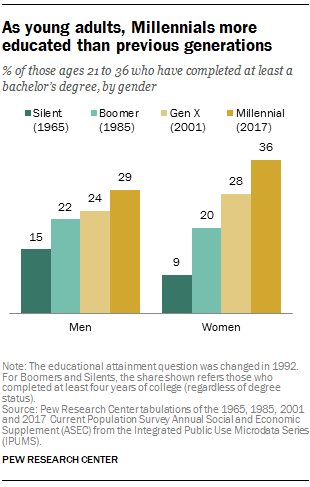The past five decades – spanning from the time when the Silent Generation (today, in their 70s and 80s) was entering adulthood to the adulthood of today’s Millennials – have seen large shifts in U.S. society and culture. It has been a period during which Americans, especially Millennials, have become more detached from major institutions such as political parties, religion, the military and marriage. At the same time, the racial and ethnic make-up of the country has changed, college attainment has spiked and women have greatly increased their participation in the nation’s workforce.
Our new interactive graphic compares the generations today and in the years that each generation was young (ages 21 to 36) to demonstrate the sea change in young adults’ activities and experiences that has occurred over the past 50 years.
Race/ethnicity in 2017
| WhiteHispanicBlackAsianOther | |
| Millennials Ages 21 to 36 Born 1981-96 |
56%
21
13
7
3
|
| Gen Xers Ages 37 to 52 Born 1965-80 |
61%
18
12
7
2
|
| Boomers Ages 53 to 71 Born 1946-64 |
72%
11
11
5
2
|
| Silents/Greatest Ages 72 and older Born before 1946 |
79%
8
8
5
1
|
| Note: Ages shown are as of 2017. Members of the Silent Generation were ages 72 to 89 in 2017. Since the Current Population Survey aggregates those ages 85 and older into one category, outcomes for members of the Silent and Greatest generations cannot be separately shown. Whites, blacks and Asians include only single-race non-Hispanics. Hispanics are of any race. Asians include Pacific Islanders. “Other races” includes non-Hispanics of other races and non-Hispanics who identify with multiple races. Figures may not add to 100% due to rounding. | |
Our analysis finds several distinctive ways that Millennials stand out when compared with the Silent Generation, a group of Americans old enough to be grandparents to many Millennials:
1 Today’s young adults (Millennials ages 21 to 36 in 2017) are much better educated than the Silent Generation. The educational trajectory of young women across the generations has been especially steep. Among Silent Generation women, only 9% had completed at least four years of college when they were young. By comparison, Millennial women are four times (36%) as likely as their Silent predecessors were to have at least a bachelor’s degree at the same age. Educational gains are not limited to women, as Millennial men are also better educated than earlier generations of young men. Three-in-ten Millennial men (29%) have at least a bachelor’s degree, compared with 15% of their young Silent counterparts. These higher levels of educational attainment at ages 21 to 36 suggest that Millennials – especially Millennial women – are on track to be our most educated generation by the time they complete their educational journeys.
Today’s young adults (Millennials ages 21 to 36 in 2017) are much better educated than the Silent Generation. The educational trajectory of young women across the generations has been especially steep. Among Silent Generation women, only 9% had completed at least four years of college when they were young. By comparison, Millennial women are four times (36%) as likely as their Silent predecessors were to have at least a bachelor’s degree at the same age. Educational gains are not limited to women, as Millennial men are also better educated than earlier generations of young men. Three-in-ten Millennial men (29%) have at least a bachelor’s degree, compared with 15% of their young Silent counterparts. These higher levels of educational attainment at ages 21 to 36 suggest that Millennials – especially Millennial women – are on track to be our most educated generation by the time they complete their educational journeys.
2A greater share of Millennial women have a bachelor’s degree than their male counterparts – a reversal from the Silent Generation. In the past half-century, growing shares of both men and women have earned a bachelor’s degree. However, women have made bigger gains over the period. Among Millennials ages 21 to 36 in 2017, women are 7 percentage points more likely than men to have finished at least a bachelor’s degree (36% vs. 29%). Back when Silents were ages 21 to 36, women were 6 points lesslikely than men to have finished at least four years of college education. Gen Xers were the first generation of women to outpace men in educational attainment, with a 3-percentage-point advantage among Gen X women ages 21 to 36. By comparison, the Baby Boom generation was the most recent in which men were better educated than women, having a 2-point advantage over young Boomer women.
3Young women today are much more likely to be working, compared with Silent Generation women during their young adult years. In 1965, when Silent women were young, a majority (58%) were not participating in the labor force and 40% were employed. Among Millennials, that pattern has flipped. Today, 71% of young Millennial women are employed, while 26% are not in the labor force. This shift to more women in the workplace occurred as early as 1985, when Boomers were young. Then, nearly seven-in-ten young Boomer women (66%) were employed and 29% were not in the labor force.